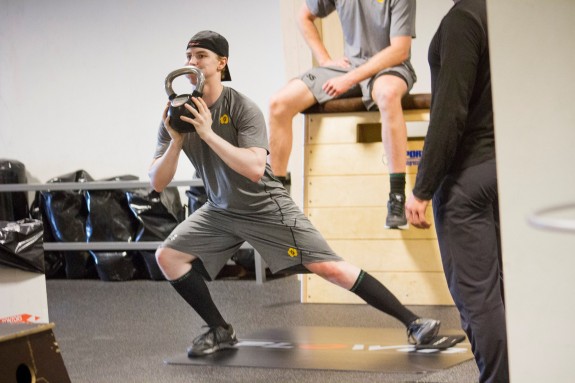Paid Post
It’s still commonplace in the hockey strength and conditioning industry to make the claims that performing powerlifting or bodybuilding exercises causes you to lose your athleticism or “function” in your specific sport.
Instead, we should be on balance boards and balls trying to mimic hockey movements. This couldn’t be further from the truth or further from what the sports science literature has to say on the development of functional strength, power, and speed.
The reality is that bodybuilding and/or powerlifting exercises won’t make you unathletic, but, ONLY doing bodybuilding or powerlifting exercises likely will decrease your athleticism. Put another way, these movements can and should be a part of a complete hockey performance-based plan — they just shouldn’t be the whole plan.
You will 100% NOT lose your athletic ability if you are still regularly incorporating athletic-based movements into your off-ice programming. It’s misguided to promote the idea that the nervous system is so fragile that because you did some isometric exercises within this training phase that you now only have the ability to move in that range of motion and you have effectively offset the years of practice you have put into the movement skills you have acquired in your sport.

This doesn’t make physiological sense and is not what we see in the real world of sport-specific training.
Rotational exercises, power work, mobility circuits, energy system specific conditioning for your position, playing the actual sport of hockey, and hockey specific speed work IN ADDITION to your bodybuilding/powerlifting movements will ensure your newfound muscle and strength that was created through the bodybuilding/powerlifting work still has the neural networking and fiber contracting ability it needs in order to function at top athletic capacities.
Just like doing some biceps curls won’t give you arms like Arnold overnight, doing a few sprints won’t make you run like Usain Bolt tomorrow. The body always adapts to what the “big picture” of your programming and periodization is, which should be a client-centered hockey specific program to enhance performance out on the ice.
I think much of the confusion comes from coaches who put strength too high up on a pedestal. They want their athletes to get as strong as humanly possible in the gym. You have to remember, we aren’t in the gym to get jacked, we are in the gym to become better hockey players. Your programming needs to reflect that and by no-means does this mean eliminate the major barbell compound movements. In fact, that would be counter-productive towards long term athletic potential.
I think also much of the confusion comes from a simple game of semantics, such as this:
“Hip extension work for explosive movement” – Athletic coach
“Glute and hamstring work for that muscle tie-in” – Bodybuilder
“Accessory lift to get stronger on the deadlift” – Powerlifter
Oh, you mean a stiff-legged deadlift?
See how function and purpose can change just by how you say it?
Many of the so-called bodybuilding/powerlifting exercises are also proper sport strength exercises as well, some people like to just repackage them to sound like an informed performance coach. When in reality it is just a movement with multiple possible adaptations depending on how you structure your sets, reps, and tempo.
At the end of the day, a complete hockey program comes down to the big picture of your yearly periodization and the level of specificity you apply to your athlete. Laying foundational muscular hypertrophy work in order to later be transferred into power, strength, and athletic function is incredibly important to incorporate every single year for a variety of reasons that go outside the scope of this blog post. It is a disservice to the industry to claim that unstable environment exercises and performing movements that look like what you do on the ice should be the exclusive methodology a plan is organized and created from.
Hockey-mimicking movements can be effective tools at certain times of the year, but they are also like paint on a house. Hypertrophy and strength work is in many cases the house, and if you don’t have a house, why are you already buying the paint?
For more hockey training information check out HockeyTraining.com.